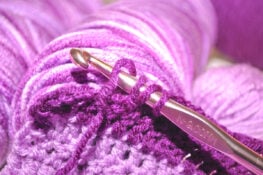
When embarking upon the mesmerizing journey of crochet, artisans frequently grapple with the challenges of efficiency and material conservation. Among the pantheon of techniques, one inquiry emerges with critical importance: which crochet stitch utilizes the least yarn? This question not only addresses the economics of fiber utilization but also unlocks a plethora of aesthetic and functional opportunities. By exploring various crochet stitches through a lens of conservation, we can enrich our craftsmanship while simultaneously cultivating an appreciation for sustainable practices in this age-old art form.
To fully comprehend the nuances of yarn consumption in crochet, one must first delve into the mechanics of each stitch. Different crochet stitches exhibit distinctive characteristics regarding their structure and density, which directly influence yarn usage. The stitches commonly employed in crochet can be broadly categorized into two groups: basic stitches and specialty stitches. Basic stitches, including chain, single crochet, half double crochet, and double crochet, form the foundation for many projects. Conversely, specialty stitches, such as popcorn, shell, and puff stitches, are characterized by their elaborate designs and expansive yarn requirements.
When considering yarn economy, one must prioritize simplicity and compactness. The single crochet stitch stands out in this regard. Renowned for its tight, dense fabric, the single crochet stitch excels at minimizing yarn usage while providing excellent durability and structural integrity. Artisans favor this stitch for smaller projects, such as amigurumi and delicate accessories, as it offers a refined finish with minimal material expenditure. Additionally, the single crochet stitch involves fewer loops and yarn overs, making it a straightforward choice for novice crocheters or those seeking efficiency.
Furthermore, the half double crochet stitch invites attention due to its versatility. This stitch strikes a balance between the single crochet and the more extravagant double crochet. While the half double crochet does use slightly more yarn than its single counterpart, it offers an appealing compromise between substance and economy. With its moderate height, this stitch can enhance the overall texture of a project while maintaining a relatively frugal approach to yarn consumption.
Another stitch that merits exploration in the realm of yarn conservation is the slip stitch. Although often overlooked, the slip stitch is a formidable contender when discussing minimal yarn usage. While primarily used for joining or creating a foundation for other stitches, the slip stitch can be employed creatively to construct intricate patterns with a remarkably economical footprint. Its low profile ensures that projects remain lightweight and delicate, preserving both the integrity of the yarn and the intended design.
Conversely, the double crochet stitch, while popular for creating airy, voluminous designs, does not fare as well in terms of yarn efficiency. The inherent height of the double crochet stitch requires more fiber, making it less desirable for those seeking to minimize material usage. Nevertheless, its ability to produce larger, more open designs can lead to increased versatility in project scope, allowing artisans to utilize lighter weight yarns for a bolder visual impact.
As creativity flourishes, so does the innovation in crochet techniques. Each stitch can be manipulated and combined in myriad ways, giving rise to unique textures and patterns. For instance, combining the single crochet stitch with the slip stitch can yield stunning visual effects while maintaining economical yarn usage. This pairing showcases that while one may search for the stitch that uses the least yarn, the true artistry lies in the thoughtful arrangement of stitches to achieve both aesthetic beauty and functional integrity.
Moreover, yarn choice plays an indispensable role in determining the efficiency of a project. The type of fiber, its ply, and even the thickness can influence the overall yarn consumption. For projects focused on minimalism, opting for a yarn with a higher yardage can extend its potential, lending itself to sustainable practices in crochet. By embracing finely spun fibers, artisans can achieve delicate, intricate designs while curbing excessive waste. Consequently, the pursuit of reduction not only encompasses stitch choice but also embraces mindful material selection.
The burgeoning inclusion of sustainable yarns further amplifies the importance of conservation within the crochet community. Many artisans are increasingly favoring eco-friendly fibers made from recycled materials or organic sources. These yarns often boast exquisite textures and hues, allowing for creativity without compromising environmental responsibility. By integrating sustainable practices into crochet, artisans contribute to a broader movement towards reducing waste in the textile industry.
As one contemplates the question, “Which crochet stitch uses the least yarn?” it becomes evident that the answer is multifaceted. Through an understanding of the properties of various stitches, one can make informed decisions on both technique and material. The single crochet stitch, with its economical design, emerges as a forerunner, while the half double and slip stitches present excellent alternatives. Ultimately, the interplay of creativity, innovation, and sustainability shaped by the choice of yarn and technique along with critical consideration of the stitch parameters contribute to the overarching goal of yarn conservation.
The intricate dance of crochet weaves not only beautiful patterns but also a narrative of mindfulness regarding resource usage. As artisans embrace a perspective rooted in conservation, the craft can evolve, merging artistry with sustainability. Thus, may the exploration of simple yet effective stitches inspire curiosity to unlock new potentials and possibilities in the enchanting world of crochet.
